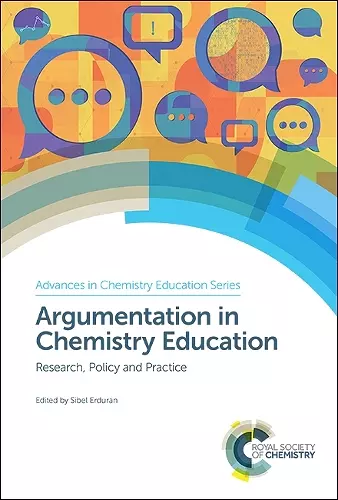Argumentation in Chemistry Education
Research, Policy and Practice
Format:Hardback
Publisher:Royal Society of Chemistry
Published:15th Feb '19
Currently unavailable, and unfortunately no date known when it will be back

Many studies have highlighted the importance of discourse in scientific understanding. Argumentation is a form of scientific discourse that plays a central role in the building of explanations, models and theories. Scientists use arguments to relate the evidence that they select from their investigations and to justify the claims that they make about their observations. The implication is that argumentation is a scientific habit of mind that needs to be appropriated by students and explicitly taught through suitable instruction.
Edited by Sibel Erduran, an internationally recognised expert in chemistry education, this book brings together leading researchers to draw attention to research, policy and practice around the inclusion of argumentation in chemistry education. Split into three sections: Research on Argumentation in Chemistry Education, Resources and Strategies on Argumentation in Chemistry Education, and Argumentation in Context, this book blends practical resources and strategies with research-based evidence. The book contains state of the art research and offers educators a balanced perspective on the theory and practice of argumentation in chemistry education.
As a person interested in the application of argumentation techniques in teaching I was glad to be given the opportunity to review this book. It is made up of work supplied by 21 different experts in the area arranged in 12 separate chapters. Each chapter covers a specific area of chemistry teaching where argumentation has been implemented and they range from secondary school to university teaching. In each case the chapters contain practical information on how to apply the argumentation technique with chapters being completed with a ‘Practical Digest’. The book starts by covering the theory behind argumentation and defines argumentation as ‘the author of a claim to knowledge makes an attempt to persuade his/her audience of the validity of his/ her claim through verbal reasoning and rebuttals’. In other words, a scientific claim is justified to an audience and is defended against rebuttal. This requires careful structuring of the material delivered to the students and the unfamiliarity of the argumentation technique by teachers features in a number of the chapters covering pre-school training of teachers and CPD development. The chapters look at a range of potential delivery mechanisms including the use of cartoon-based material for secondary school teaching. There are numerous references in the book to the difficulties in assessing these teaching strategies with particular reference to marking the construction of arguments. There is a specific chapter covering this area with some very helpful suggestions in the computer technology support chapter. The computer chapter also covers electronic communities which have been set-up to support argumentation implementation. One area that I believe lends itself to the implementation of argumentation is practical work. Here the acquisition of ‘real’ data is ideal for stimulating discussion and rebuttal. The book contains a chapter covering this area with a number of suggestions to help the introduction of some of the techniques with discussion of potential drawbacks. One suggestion made to encourage discussion of chemistry was to introduce it in the context of societal impact. Again a chapter is included covering this area with mention of applications also included in other chapters within the book. Some specific applications are covered in the chapters on organic and physical chemistry teaching. It is a pity that the two other areas of chemistry, inorganic and analytical, are not covered in such detail. The technique is heavily dependent on verbal reasoning and discussions are held in two chapters in the book about the issues associated with students who may suffer in this area. Overall, I particularly enjoyed this book and would recommend it to anyone looking for a background and practical guide to the implementation of argumentation as a teaching technique for chemistry. The majority of the suggested delivery techniques could be easily adapted to a range of chemical areas and the recorded verbal feedback would give an insight to potential student responses which is invaluable. There are some small issues related to the book’s production. Some of the diagrams are of relatively poor quality but this could be in the version I was provided for the review. There were also a number of basic text errors which had not been identified in the editing process, but they did not affect my enjoyment of the book. -- Phil Riby, Liverpool John Moores University * Chromatographia *
ISBN: 9781788012126
Dimensions: unknown
Weight: 628g
320 pages